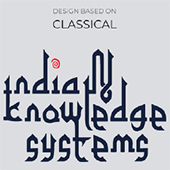Alice Boner was a Swiss-trained sculptor and artist who lived in Varanasi, India in the twentieth century. The diary she kept for documenting her observations offers fascinating insights into her discoveries about the geometrical underpinnings of Indian art [21].
One such analysis was that of an 8th century panel in Elura Caves, called Narasimha Avatar. The image, as shown in Figure 24, conveys energy and tension of the moment, as Vishnu, transformed into the form of a manlion called Narasimha, prepares a death-dealing blow to the asura Hiranyakasipu. Alice Boner’s suggestion is that although the panels are square or rectangular, the primary geometrical feature is a single circle, inscribed in the square or having two opposing sides as tangents in a rectangular case. This primary circle is divided by diameters, here 8, and generally 6, 8, or 12, into equal sectors, the vertical and horizontal diameters being fundamental. The intersections of the diameters with the circle form the basis of a rectangular grid, as seen on the left side of Figure 24. Note that the grid spacing varies vertically and horizontally. This forms what she calls the space division of image. It is static in nature and serves to locate the important elements of the composition. It can be seen how the vertical neatly divides the space for the two opposing forces. The two central grid interspaces are taken with the bodies of Narasimha and the asura, while the horizontal interspaces divide the bodies into the heads, torsos, and thigh regions. More interestingly, the right side of Figure 24 shows what are called time divisions, using oblique grids. They are obtained by selecting two or three families of parallel chords, also based on the cutting points of the diameters and the circle. The time divisions determine the direction of movement [21].

Figure 25: Alice Boner’s Analysis of Sumhara Kali
Boner analyses 21 panels in this manner. Another example of a grid superimposition on a 2D composition can be seen in the Sumhara Kali figure, as shown in Figure 25. Looking at the right side image, the grid shows a circle centred exactly on the navel of Kali. There are six diameters and the space and time divisions (superimposed here) are straightforward.
Figure 26 shows a scene from the Mahabharata, with Arjuna standing on his chariot and Krishna driving it. The panel is elongated into a rectangular shape. Geometrically there are three equal circles, centred one radius apart, the centres being directly between the eyes of Vishnu, on his navel, and on a multi-headed serpent. The circles cover heaven, the earth, and the underworld.

Figure 26: Alice Boner’s Analysis of Vishvarupa
The division is by 12 diameters. The space division is used to indicate repetition and hence order and form, while the time division shown by the oblique lines emphasizes its vastness.

